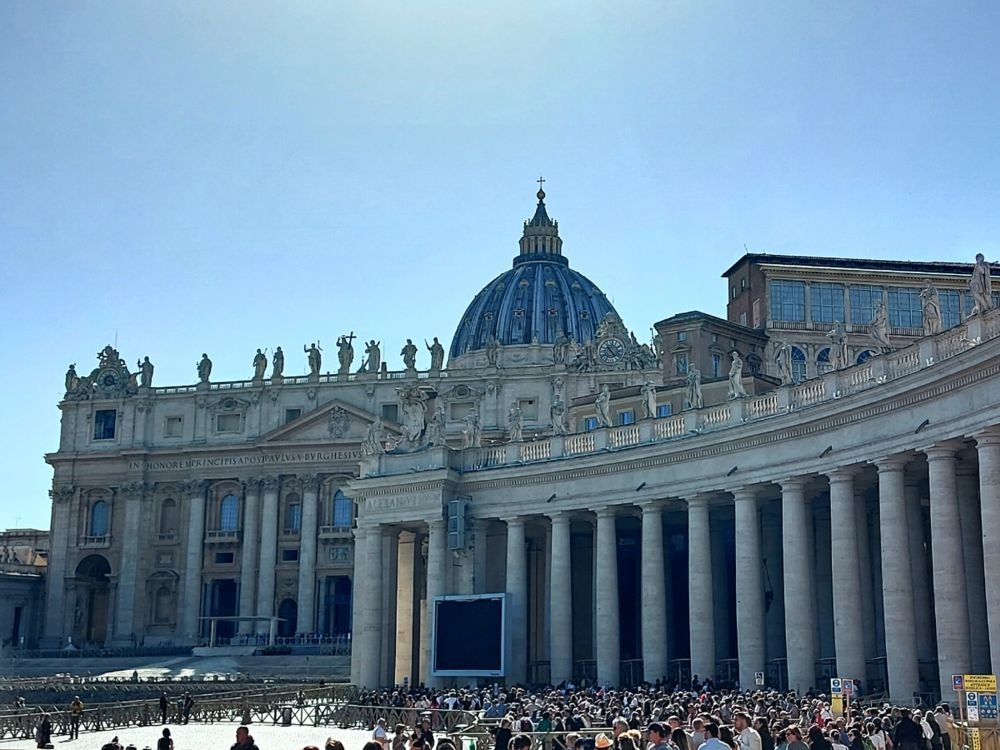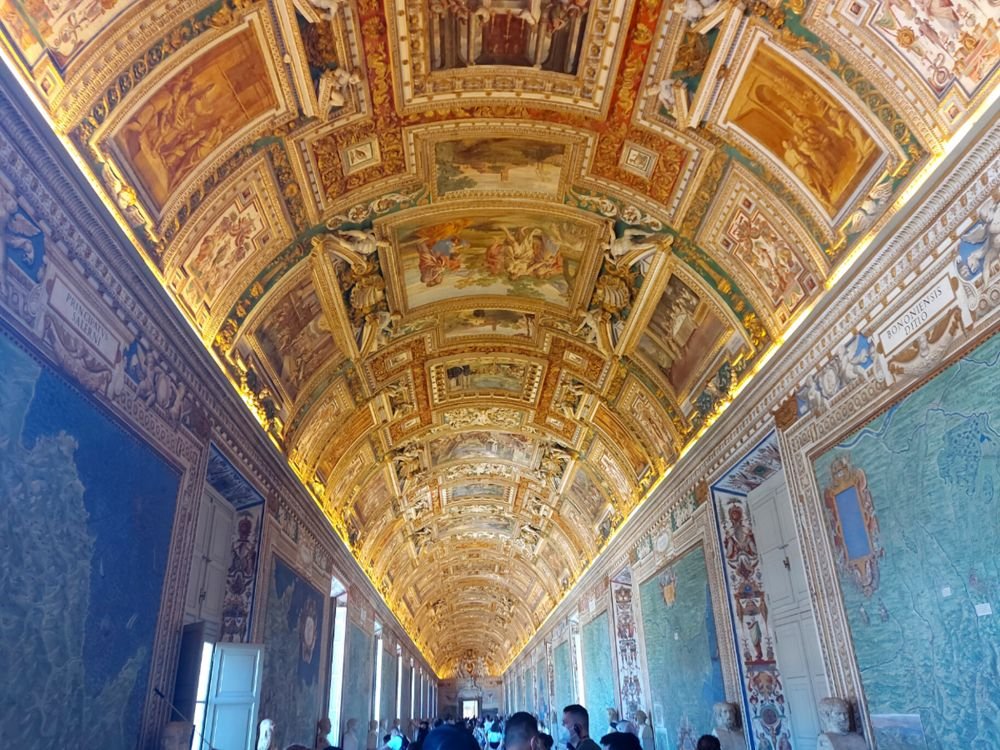
Resistance, Reformation, and Renaissance: Lessons from the Worldview Battle in Rome
When culture and Scripture disagree, who do we side with? Here's how different answers to that question have played out across the centuries in Rome and what this history means for Christians today.
Behind the stone walls which stretched skyward from the pavement where I stood, countless life stories had ended. Those walls had once resounded with the roar of crowds, the clash of steel, and the shouts of gladiators. But the battles fought in Rome’s Colosseum were only shadows of the real warfare in this city. The greater conflict lay in an age-old battle of worldviews, with humans waging a futile—and disastrous—war against their Creator’s infallible Word.

Inside the Colosseum.
With its significance for the early church, Reformation, and Renaissance, Rome offers a central vantage point from which to understand the worldview battle still raging in Western culture—a battle which extends to the Neo-Marxist ideas storming society today. That’s why I’d chosen this city as the official starting point for my backpacking journey to trace the history and consequences of Marxism.
To see how Rome’s past offers practical reminders for Christ followers today, let’s take a quick tour through the Western worldview battle in Rome.
Resistance: Early Church vs. Pagan Culture
Follow the flocks of tourists through Rome’s labyrinthine streets, and you’ll find a mammoth monument to paganism: the Pantheon. Given that pan means “all” and theos refers to divinity, you might guess the Pantheon once housed a smorgasbord of idols—and you’d be right. From the “god of cattle worms”1 to the “goddess of grain mildew,”2 the Romans worshipped a pantheon of mythic deities. But no idols—not even those hewn from the toughest stone—can provide a solid worldview foundation on which to build a culture. As the famous Christian scholar Francis Shaeffer pointed out,
Like the Greeks, the Romans had no infinite god. This being so, they had no sufficient reference point intellectually; that is, they did not have anything big enough or permanent enough to which to relate either their thinking or their living. Consequently, their value system was not strong enough to bear the strains of life, either individual or political. All their gods put together could not give them a sufficient base for life, morals, values, and final decisions.3

The Pantheon.
As a result, Rome increasingly turned to the worship of more animate idols: emperors. A period called the Great Persecution began as one such emperor, Diocletian, decreed edicts which placed increasing pressure on Christians.4 (Remember the process Diocletian used—we’re going to see similar patterns in future posts as we trace the history of totalitarian regimes.)

Overlooking the ruins of ancient Rome.
First, Diocletian dismissed soldiers and palace officials who refused to sacrifice to Roman deities. Next, he ordered the removal of Christian texts and church buildings, prohibited Christians from holding services, and restricted Christians’ legal rights. He then issued an edict that spelled imprisonment for clergy members, adding a subsequent edict which granted clergy freedom if they offered Roman sacrifices. Meanwhile, Diocletian’s government found ways to scapegoat Christians for local crises, whether “failed sacrifices” or palace fires. Finally, in AD 304, a universal decree gave Christians an ultimatum: sacrifice or endure punishments, including torture, imprisonment, and death.5
Thousands of believers refused to compromise with the Roman government’s unbiblical demands—and faced horrific deaths as a result. But remember, the Christians could have avoided these fates. All they had to do was go along with their culture, blending a Roman worldview with Christianity by adding the worship of local deities to their worship of Jesus. However, that would have meant following man’s word (or human-made religion) as the authority above God’s Word, which says, “You shall have no other gods before me.”6 Where culture and Scripture disagreed, many believers in Rome followed God’s Word on pain of death.

A cross inside the Colosseum memorializes Rome’s Christian martyrs.
Reformation: The Need for a Return to God’s Word
After Diocletian and his co-emperor resigned, one of the new emperors, Constantine, issued the Edict of Milan in AD 313, granting religious freedom.7 The Christianization of Rome soon began, with the church remaining central to much of Europe’s civil and political life long after the decline of the Roman Empire. But as the centuries unfolded, three related veins of compromise corroded the worldview foundation beneath Western culture’s Christianized veneer:8
- Compromise on biblical authority
Instead of accepting God’s Word as their authority for truth, many Christians began viewing human-made teachings and church traditions from outside the Bible as though equal to Scripture. (Part of this problem stemmed from the fact that most Christians could not access God’s Word for themselves—a limitation which Western Christians do not share today, thanks largely to the courage of men, including John Wycliffe and William Tyndale, who translated Scripture in opposition to man’s decrees.) - Compromise on biblical doctrine
Tolerating the syncretism of man’s word with God’s Word opened the door for Christians to import more and more unbiblical teachings into their beliefs. For instance, people increasingly viewed salvation as a reward for human efforts rather than accepting the Bible’s revelation that salvation is God’s gift of grace made possible through Jesus alone.9 - Compromise with pagan philosophy
Along the way, many mainstream believers began incorporating secular teachings into their Christianity. For instance, the prominent theologian Thomas Aquinas (1225–1274) emphasized the pagan Greek philosopher Aristotle to the point that Aristotle’s teachings became treated as official church doctrine.10

St. Peter’s Basilica, Vatican City.
Realizing that Western culture’s mainstream religion had drifted alarmingly far from God’s Word, Reformers, including Martin Luther (1483–1546), urged the church to return to its foundation of biblical authority.
Renaissance: Culture Aligns Itself to Man’s Word
In the years between Aquinas and Luther, Western culture’s renewed emphasis on pagan Greece and Rome gave way to a full-blown revival of classical philosophy—a shift known as the Renaissance, named after the French term for “rebirth.” Following the teachings of Aristotle, Renaissance thinkers believed that humans could construct their own meaningful view of reality by reasoning about the pieces of the world they could perceive around them rather than by beginning with God as the objective authority for truth and meaning.11 To glimpse a famous example of this thinking in sixteenth-century Rome, let’s head to the nearby Vatican Museum.

Walking through the Vatican Museum.
Shuffle your way through the crowds streaming through the museum’s gilded corridors, and you’ll (eventually) wind up in the Sistine Chapel, famed for its paintings by Renaissance artist Michelangelo (1475–1564). One scene shows how Michelangelo envisioned the creation of man, with God and Adam nearly touching. For centuries, people have viewed this painting as symbolizing how humans are created in the image of God, whose Word is our authority for truth. But more recently, scholars have suggested Michelangelo’s depictions of God may contain or exist inside illustrations of the human brain.12 Was Michelangelo implying that “people created God,” meaning that human thoughts and feelings are the authority for truth?13

The Creation of Adam scene, painted c.1512 by Michelangelo.
Whether or not this interpretation of Michelangelo’s artwork is correct, such humanistic thinking gained rapid traction during the Renaissance, reflecting Satan’s original lies, “Did God actually say . . .?” and “You will be like God.”14 To believe these lies and make ourselves the authority for truth is to leave the ultimate foundation for truth, logic, morality, justice, and human value, which God’s Word supplies. This leads to disastrous consequences and paves the way for later totalitarian regimes, including those influenced by Karl Marx.
From Michelangelo to Marx
Marx, an atheist, believed that humanity evolved without a Creator and therefore must “create” itself.15 This process of self-creation, according to Marx, involves laboring toward the development of a atheistic, communistic society that would free humanity to reach its full potential.16 To make this claim that man is his own creator, Marx first had to discount Genesis—a step which the increasingly popular ideas of millions of years and evolutionary origins seemed to justify.17 Summarizing these views, Marx stated:
The creation of the earth has received a mighty blow from geognosy—i.e., from the science which presents the formation of the earth, the development of the earth, as a process, as a self-generation. . . . But for the socialist man, the entire so-called history of the world is nothing but the creation of man through human labour, nothing but the emergence of nature for man, so he has the visible, irrefutable proof of his birth through himself, of his genesis.18

Staircase of Vatican Museum.
We can see traces of Marx’s man-centered religion in Renaissance-era humanism reflected in other works by Michelangelo. For instance, when describing a room which displays some of Michelangelo’s most famous sculptures, Francis Shaeffer noted,
Here we see on either side Michelangelo’s statues of men “tearing themselves out of the rock.” These were sculpted between 1519 and 1536. They make a real humanistic statement: Man will make himself great. Man as Man is tearing himself out of the rock. Man by himself will tear himself out of nature and free himself from it. Man will be victorious.19
From Michelangelo to Marx, we see the recurring, fatal pattern of humans rejecting God’s Word to try making themselves “like God”—a pattern as old as Eden.
The Battle Continues
In today’s Western society, the cultural descendant of Rome, we see the same pattern unfolding at every turn. We again find ourselves at the front lines of the ancient worldview battle where humans wage a futile war against their Creator. We see this battle in Marx’s call for man to create himself via communism. We see it in the Renaissance times and the centuries of church compromise which led to the need for the Reformation. And we see it among the early believers in Rome, where standing on God’s Word over man’s meant facing horrific deaths.

Outside the Colosseum.
Like these early Christians, we live in a culture that disagrees with God’s Word on many points. We’re told that when culture and Scripture disagree, we can reinterpret Scripture accordingly—even though doing so means following man’s word over God’s. Today, it’s no secret that the pressure to compromise with man’s word is growing ever stronger, due in part to Neo-Marxist movements which label Bible-believing Christians as oppressors who must be overthrown. Surrounded by the roar of crowds, we must join the early Roman believers in resolving to stand on the Word of our Creator, Jesus. We can fix our eyes on him with confidence, knowing he has already won the war.
Footnotes
- “Verminus,” Lawrence Richardson, A New Topographical Dictionary of Ancient Rome (Baltimore: John Hopkins University Press, 1992), 411.
- “Robigo,” Christian Smith, “The Religion of Archaic Rome,” A Companion to Roman Religion, ed. Jörg Rüpke (Malden: Blackwell Publishing, 2007), 37.
- Francis Shaeffer, How Should We Then Live? (Old Tappan: Fleming H. Revel, 1976), 21. (Note that Francis Shaeffer unfortunately adopted a compromised view on the age of the earth, although his philosophical analysis of Western culture remains extremely relevant. For more information, see Calvin Smith, “A Tale of Two Prophets,” Answers in Genesis, October 19, 2020, https://answersingenesis.org/blogs/calvin-smith/2020/10/19/a-tale-of-2-prophets/.)
- Hartmut Leppin, “Old Religions Transformed: Religions and Religious Policy from Decius to Constantine,” A Companion to Roman Religion, ed. Jörg Rüpke (Malden: Blackwell Publishing, 2007), 103.
- You can read an eyewitness account of the rise of the Great Persecution, and what happened during it, in Eusebius of Caesarea’s (c. AD 260–339) manuscript Martyrs of Palestine, with several English translations available online. (Note that much of the content, understandably, contains graphic descriptions of violence.)
- Exodus 20:3.
- Hartmut Leppin (2007), 104.
- See Francis Shaeffer (1976), 56.
- E.g., Ephesians 2:8–9.
- For more on how classical philosophy became incorporated in the mainstream Western church, see Dr. Danny Faulkner, The Expanse of the Heavens: Where Creation and Astronomy Intersect (Green Forest: Master Books, 2017), 48–52, available at https://answersingenesis.org/store/product/expanse-heaven/.
- See Francis Shaeffer (1976), 51–56. This human-centered approach might seem reasonable at first glance but deprives humans of a foundation for reason in the first place. For more information, see the resources linked in “6 Principles Skeptics Borrow from the Bible,” or Dr. Jason Lisle, The Ultimate Proof of Creation (Green Forest: Master Books, 2009).
- Frank Lynn Meshberger, “An Interpretation of Michelangelo’s Creation of Adam Based on Neuroanatomy,” Journal of the American Medical Association, 264, no. 14 (1990): 1837–1841; Ian Suk and Rafael Tamargo, “Concealed Neuroanatomy in Michelangelo’s Separation of Light from Darkness in the Sistine Chapel,” Neurosurgery 66, no. 5 (2010): 851–861; and J. Wesson Ashford and Sue Binkley Tatem, “Michelangelo’s Sistine Chapel Frescoes: Communications About the Brain,” Neurocase 26, no. 5 (2020): 293–298.
- Meshberger (1990), the first researcher to describe Michelangelo’s potential brain illustrations, interprets this imagery as symbolizing how God created man’s intellect; however, the idea that Michelangelo meant to imply that human minds invented God is the interpretation I was taught in one of my university labs. (Notably, a similar blasphemous emphasis on ‘man creating God in his own image’ was central to the thinking of the German philosopher Ludwig Feuerbach, who greatly influenced Karl Marx. See Kathleen Clarkson and David Hawkin, “Marx on Religion: The Influence of Bruno Bauer and Ludwig Feuerbach on His Thought and Its Implications for the Christian-Marxist Dialogue,” Scottish Journal of Theology 31, no. 6 (1978): 533–555.) It is also worth noting that Ashford and Tatem (2020) interpret Michelangelo’s portrayals of the days of creation as depicting a progressive development of the vertebrate brain through fish, amphibian, and mammal stages.
- Genesis 3:1–5.
- E.g., see Karl Marx, “Private Property and Communism,” Economic and Philosophic Manuscripts of 1844, trans. Martin Milligan (New York: International Publishers, 1964), 144–145.
- Ibid.
- See Jerry Bergman, “The Darwinian Foundation of Communism,” Journal of Creation 15, no. 1 (April 2001): 89–95, https://answersingenesis.org/charles-darwin/racism/the-darwinian-foundation-of-communism/; and Jerry Bergman, “Fredrich Engels Introduced Darwin to Karl Marx and Changed the World,” Answers Research Journal 14 (2021): 463–472, https://answersresearchjournal.org/charles-darwin/engels-darwin-marx/. See also Darwin’s On the Origin of the Species, which popularized evolution by natural selection, was published 12 years after Marx’s essay cited above; however, earlier evolutionary ideas long predated Darwin.
- Ibid. Emphasis in original.
- Francis Shaeffer (1976), 71. See also pages 71–72 for an analysis of the humanistic elements reflected in Michelangelo’s famous sculpture David.

Answers in Genesis is an apologetics ministry, dedicated to helping Christians defend their faith and proclaim the good news of Jesus Christ.
- Customer Service 800.778.3390
- © 2024 Answers in Genesis
